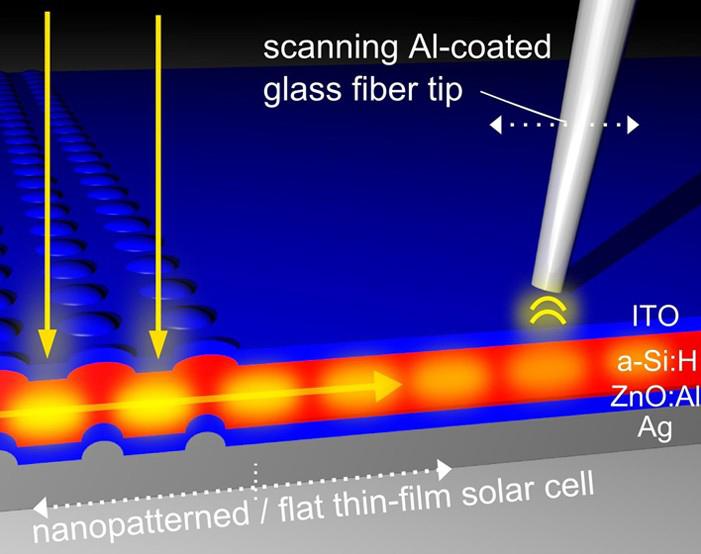Light propagation in solar cells made visible

Through use of a glass fibre tip, the researchers were able to measure the amount of light that had actually been captured in the solar cell using a method called near-field optical microscopy. Credit: Forschungszentrum Jülich
Until recently, light trapping within periodically nanostructured solar cells could only be analysed using indirect methods, as captured light is not visible from outside of the solar cell.
However, the quantum mechanical tunnelling effect of light allows it to be tracked if a light-conducting component is brought extremely close to the cell's surface.
Through use of a glass fibre tip, the researchers were able to measure the amount of light that had actually been captured in the solar cell using a method called near-field optical microscopy.
Light trapping plays a particular important role in optimizing thin-film solar cells. These solar cells are easier to manufacture and require less material than conventional crystalline solar cells, but they are not yet as efficient.
The layer in which energy conversion takes place is only about one thousandth of a millimetre thick. Therefore, longer wavelengths in the infrared region are only poorly absorbed when the cell is exposed to direct sunlight.
Periodically nanopatterned interface layers allow for better absorption of the incident light. These interfaces couple incident light into the thin silicon layer. Based on the new experimental approach, scientists from the Institute of Energy and Climate Research at Forschungszentrum Jülich showed that there is a direct link between the nature of the nanostructure, the absorption of specific wavelengths of light, and in particular the efficiency of the solar cell.
The approach, presented in the specialist journal Nano Letters (DOI: 10.1021/nl503249n), also opens a range of new possibilities for investigating applied nano-optical components.
Media Contact
More Information:
http://www.fz-juelich.deAll latest news from the category: Power and Electrical Engineering
This topic covers issues related to energy generation, conversion, transportation and consumption and how the industry is addressing the challenge of energy efficiency in general.
innovations-report provides in-depth and informative reports and articles on subjects ranging from wind energy, fuel cell technology, solar energy, geothermal energy, petroleum, gas, nuclear engineering, alternative energy and energy efficiency to fusion, hydrogen and superconductor technologies.
Newest articles

High-energy-density aqueous battery based on halogen multi-electron transfer
Traditional non-aqueous lithium-ion batteries have a high energy density, but their safety is compromised due to the flammable organic electrolytes they utilize. Aqueous batteries use water as the solvent for…

First-ever combined heart pump and pig kidney transplant
…gives new hope to patient with terminal illness. Surgeons at NYU Langone Health performed the first-ever combined mechanical heart pump and gene-edited pig kidney transplant surgery in a 54-year-old woman…

Biophysics: Testing how well biomarkers work
LMU researchers have developed a method to determine how reliably target proteins can be labeled using super-resolution fluorescence microscopy. Modern microscopy techniques make it possible to examine the inner workings…





















